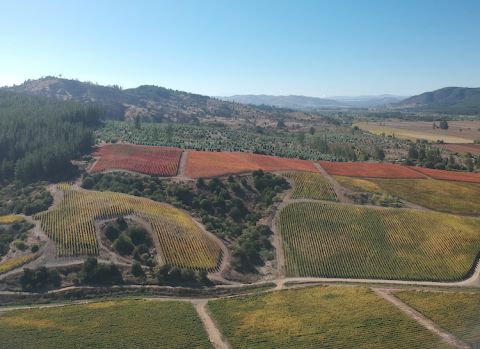From €17.55, £15.50, $28, 615.04 Czech koruna.
Here in the Languedoc we are braced for a weekend when the forecast temperatures are 40 °C (104 °F) on Saturday and 41 °C (106 °F) on Sunday. My wine of the week today comes from a new DO in Chile where the average maximum summer daytime temperature is 27 °C, or 80 °F (described by Chileans as ‘fresh’, apparently). And virtually every afternoon the vineyards here are cooled by a breeze from the Pacific 25 km away.
This magically ‘fresh’ wine region is Licantén, a coastal area within the Curicó Valley, in the middle of your online World Atlas of Wine map of central Chile. It has been developed uniquely by the Orueta family of La Roncière, who had been making wine inland since 1949 but were concerned that these inland wine regions were warming up alarmingly so started to search for cooler climes.
After a four-year search they bought 200 ha (494 acres) of extremely varied soils, expositions and elevations in 2014 and in 2018 Licantén was recognised as an official Chilean DO where they are so far the only wine producer. Soil types include the llicorella more commonly found in Priorat, shale, gravel and some granitic loam. They have planted only red wine varieties, quite a punt in an untried region, and undertook many a microvinification from their 140 small plots of vines. This is the general result of their variety and soil matching:
- Cabernet Franc: schist and rock
- Malbec: granite
- Merlot: granite and schist
- Cabernet Sauvignon: granite and schist
La Roncière, Idahue Estate Malbec 2021 Licantén also contains 8% Merlot and 7% Cabernet Franc and I came across it at the big Chilean tasting described in Chile’s best in 2023? published earlier this month. It stood out as by far the best-value wine of the 85 I tasted. My delighted note reads:
Proper wine! Complex yet accessible with a lovely dry, dusty appeal and light leafiness. Well bought! VGV 16.5/20 Drink 2023–27
It is 14% alcohol but certainly doesn’t taste heavy or alcoholic – indeed it tastes as though it had been grown somewhere very, well, fresh. As for its longevity, its UK importer Corney & Barrow suggests that it will last until 2031. Presumably this is the suggestion of their clever South American buyer Rebecca Palmer, who writes about La Roncière:
I think they’re just terrific, rather ‘apart’ from the rest; the wines are so fresh and fine, and even in a cool vintage they never fall into meanness. I sense a more distinctive character and definition emerging with every vintage too, which is super-rewarding for me as a buyer (and I have to admit, something of a relief too … there’s no doubt that even though I’ve been at C&B for a long time now, there’s an invisible but very tangible additional dimension of responsibility involved in taking on a new producer).
Of course great minds think alike and I now see that Julia chose the 2017 vintage of this wine as her wine of the week back in 2020. In her article you will find all manner of background information so I will give only updates on that.
Winemaker Juan Muñoz describes the 2021 vintage as ‘very special in terms of quality and typicity. We had enough rains and snow during winter to guarantee irrigation water for all the season and after fresh temperatures during spring and summer to have a calm and quiet maturation. In January and February we had small rains but it didn't affect the sanity [health] of our grapes. The harvest began one week later than usual. The grapes, juice and wine later show with full colour and typicity expression. It appears as we were drinking wine from the bunches directly.’
They have only 4.28 ha (10.6 acres) of Malbec, the plants coming from two different sources. They had some 30- to 35-year-old Malbecs (mass selection and originally misidentified) in one of their vineyards in Curicó, and decided to make cuttings and propagate them in Licantén. The rest of the Malbec is the bordelais Cot clone 180.
Selected yeasts ferment the wine at 16–28 °C for about seven days, followed by a 30-day maceration before racking to the 228-litre barrels of which Chileans are so fond. The wine is routinely aged for almost a year in barrels from a range of France’s top coopers, about 30% new and the rest second, third and fourth use. Muñoz says about them, ‘a common characteristic of all of them is the respect for the wine and its fruit. Some of them are expensive but for us is necessary to age the wine a year in the same barrel.’ Palmer adds, ‘they want a bit of new oak for structure and aroma/flavour but no more than that. They are more and more careful about new barrels apparently, finding new oak often too aggressive, even as the vines mature. They also use some 10-hl tinajas (stoneware ceramic eggs)’.
The Idahue estate is certified by the Wines of Chile Sustainability Code, which doesn’t require organic viticulture but does required a long-term commitment to sustainable development in not only the environment, but also economic viability and social equity.
Importers are:
- UK – Corney & Barrow
- USA – SAWM
- Mexico – Club del Gourmet
- Taiwan – Wineswee
- China – various
- Finland – KESPRO
- Germany – Chilenus
- Czech Republic – 8wines
Wine-Searcher.com lists three retailers in the US and also Blanco & Gomez in the UK as well as a retailer in each of Germany and the Czech Republic.
See many more current Chilean wines reviewed in Chile’s best in 2023?















